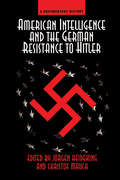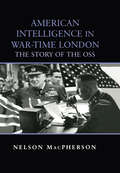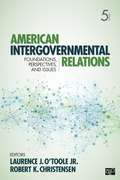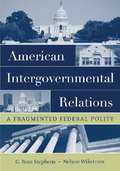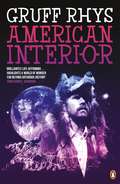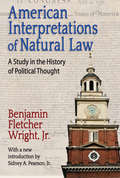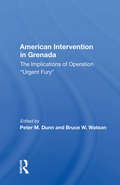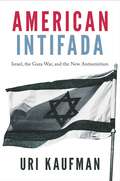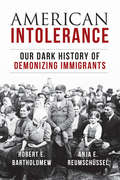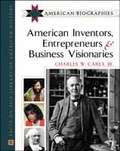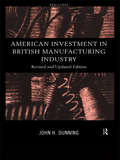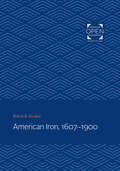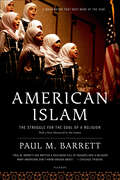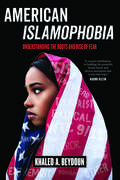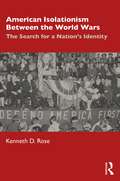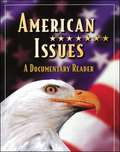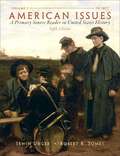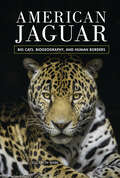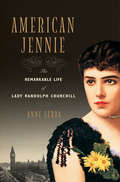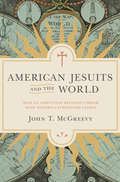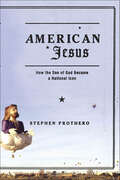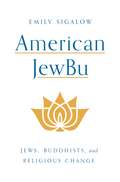- Table View
- List View
American Intelligence And The German Resistance: A Documentary History
by Jurgen HeidekingEven paranoids have enemies. Hitler's most powerful foes were the Allied powers, but he also feared internal conspiracies bent on overthrowing his malevolent regime. In fact, there was a small but significant internal resistance to the Nazi regime, and it did receive help from the outside world. Through recently declassified intelligence documents, this book reveals for the first time the complete story of America's wartime knowledge about, encouragement of, and secret collaboration with the German resistance to Hitler?including the famous July 20th plot to assassinate the Fuehrer.The U.S. government's secret contacts with the anti-Nazi resistance were conducted by the OSS, the World War II predecessor to the CIA. Highly sensitive intelligence reports recently released by the CIA make it evident that the U.S. government had vast knowledge of what was going on inside the Third Reich. For example, a capitulation offer to the western Allies under consideration by Count von Moltke in 1943 was thoroughly discussed within the U.S. government. And Allen Dulles, who was later to become head of the CIA, was well informed about the legendary plot of July 20th. In fact, these secret reports from inside Germany provide a well-rounded picture of German society, revealing the pro- or anti-Nazi attitudes of different social groups (workers, churches, the military, etc.). The newly released documents also show that scholars in the OSS, many of them recruited from ivy-league universities, looked for anti-Nazi movements and leaders to help create a democratic Germany after the war.Such intelligence gathering was a major task of the OSS. However, OSS director ?Wild Bill? Donovan and others favored subversive operations, spreading disinformation, and issuing propaganda. Unorthodox and often dangerous schemes were developed, including bogus ?resistance newspapers,? anti-Nazi letters and postcards distributed through the German postal service, sabotage, and fake radio broadcasts from ?German generals? calling for uprisings against the regime.This is much more than a documentary collection. Explanatory footnotes supply a wealth of background information for the reader, and a comprehensive introduction puts the documents into their wider historical perspective. Arranged in chronological order, these intelligence reports provide a fascinating new perspective on the story of the German resistance to Hitler and reveal an intriguing and previously unexplored aspect of America's war with Hitler.
American Intelligence in War-time London: The Story of the OSS
by Nelson MacPhersonBased on OSS records only recently released to US National Archives, and on evidence from British archival sources, this is a thoroughly researched study of the Office of Strategic Services in London. The OSS was a critical liaison and operational outpost for American intelligence during World War II. Dr MacPherson puts the activities of the OSS in
American Intergovernmental Relations
by Laurence J. O'Toole Robert K. ChristensenWith the addition of brand new co-editor, Robert Christensen, this trusted reader is back in a fresh and insightful fifth edition. To the general structure that has made American Intergovernmental Relations so enduring, the editors have added a new section that incorporates the importance of law and courts to intergovernmental relations. This new section explicitly grounds the study of intergovernmental relations to foundational Constitutional text and the dynamic role of the Supreme Court in interpreting constitutional powers. O'Toole and Christensen have also added new selections that cover society's current and most pressing intergovernmental policy issues, including health care, immigration, and the evolving and controversial issue of medical marijuana. As always, each essay is judiciously edited and substantial part introductions further contextualize each essay's contribution to make American Intergovernmental Relations an accessible and invaluable text, as well as an engaging read.
American Intergovernmental Relations: A Fragmented Federal Polity
by G. Ross Stephens Nelson WikstromThe one constant in the American federal system is change--change that is not always beneficial. American Intergovernmental Relations: A Fragmented Federal Polity examines how the dynamic social, economic, and political forces that impinge on American government at all levels shape the waythat our federal system functions. Stephens and Wikstrom--both senior scholars specializing in federalism, intergovernmental relations, and fiscal policy--offer concise, comprehensive, and easy-to-understand coverage of these materials. Beginning with the key elements of federalism, the authors trace these principles as they haveevolved since the founding of the republic and through the various phases and types of federal arrangements as they exist today. They examine and analyze the extreme complexity of the system and the cooperative and conflicting components of vertical and horizontal intergovernmental relations. Stephens and Wikstrom also discuss the impact of public policy and intergovernmental relations on American society in light of rising globalism, rapidly changing technology, and new security concerns. Featuring relevant case studies from the headlines, American Intergovernmental Relations is anideal text for undergraduate and graduate courses in federalism and intergovernmental relations. It is also an excellent text for a different approach to a course in American government.
American Intergovernmental Relations: Foundations, Perspectives and Issues (3rd edition)
by Laurence J. O'Toole Jr.Introduces classic essays and contemporary problems - all put in historic perspective by the editor's insightful and superb commentary. - From back cover
American Interior: The Quixotic Journey of John Evans
by Gruff RhysAmerican Interior is a psychedelic historical travelogue from Welsh pop legend Gruff Rhys.In 1792, John Evans, a twenty-two-year-old farmhand from Snowdonia, Wales, travelled to America to discover whether there was indeed, as widely believed, a tribe of Welsh-speaking native Americans still walking the great plains. In 2012, Gruff Rhys set out on an 'investigative concert tour' in the footsteps of John Evans, with concerts in New Orleans, Baltimore, Philadelphia, Pittsburgh, Cincinnati, St Louis, North Dakota and more. American Interior is the story of these journeys. It is also an exploration of how wild fantasies interact with hard history and how myth-making can inspire humans to partake in crazy, vain pursuits of glory, including exploration, war and the creative arts. Gruff Rhys is known around the world for his work as a solo artist as well as singer and songwriter with Super Furry Animals and Neon Neon, and for his collaborations with Gorillaz, Dangermouse, Sparklehorse, Mogwai and Simian Mobile Disco amongst others. The latest album by Neon Neon, Praxis Makes Perfect, based on the life of radical Italian publisher Giangiacomo Feltrinelli, was recently performed as an immersive live concert with National Theatre Wales.
American International Group - 2010
by Jay W. Lorsch Melissa BartonThe AIG Board underwent significant restructuring after the company was bailed out by the U.S. government in September 2008 in the midst of the financial crisis.
American Interpretations of Natural Law: A Study in the History of Political Thought (Library Of Liberal Thought Ser.)
by Benjamin Fletcher WrightThis book illustrates the deep roots of natural law doctrines in America's political culture. Originally published in 1931, the volume shows that American interpretations of natural law go to the philosophical heart of the American regime. The Declaration of Independence is the preeminent example of natural law in American political thought�it is the self-evident truth of American society.Benjamin Wright proposes that the decline of natural law as a guiding factor in American political behaviour is inevitable as America's democracy matures and broadens. What Wright also chronicled, inadvertently, was how the progressive critique of natural law has opened a rift between and among some of the ruling elites and large numbers of Americans who continue to accept it. Progressive elites who reject natural law do not share the same political culture as many of their fellow citizens.Wright's work is important because, as Leo Strauss and others have observed, the decline of natural law is a development that has not had a happy ending in other societies in the twentieth century. There is no reason to believe it will be different in the United States.
American Intervention In Grenada: The Implications Of Operation ""Urgent Fury""
by Peter M DunnWhy did the United States invade the sovereign state of Grenada in October 1983, risking world condemnation and the possible escalation of violence outside the borders of the tiny Caribbean island? According to the contributors to this book, the invasion-code-named "Urgent Fury"--was a product of the increasing concern with political instability in
American Intifada: Israel, the Gaza War and the New
by Uri KaufmanWhy are progressives so hostile to Israel?Listen to commentators and a pattern quickly emerges: the more liberal the speaker, the more likely they are to attack Israel. Worse, many liberals say things about Israel that are patently false. After the October 7 Hamas attack, Barack Obama said that Israel had &“unclean hands&” because of the &“unbearable occupation&”. The trouble was, there was no occupation. Israel had withdrawn from Gaza almost twenty years before. With his acclaimed wit, historian Uri Kaufman answers the riddle by examining the phenomenon through the distorting lens of race. Simply put, Israelis are perceived as a white group of privilege, while Palestinians are perceived as people of color. For progressives, fighting for people of color is the core value that crowds out all other considerations, no matter the facts. It all results in a strange upside-down world where liberals attack Israelis who share their values, while embracing Palestinians who reject them.
American Intolerance: Our Dark History of Demonizing Immigrants
by Robert E. Bartholomew Anja ReumschuesselThis historical review of the US treatment of immigrants and minority groups documents the suspicion and persecution that often met newcomers and those perceived to be different.Contrary to popular belief, the poor and huddled masses were never welcome in America. Though the engraving on the base of the Statue of Liberty makes that claim, history reveals a far less-welcoming message. This comprehensive survey of cultural and racial exclusion in the United States examines the legacy of hostility toward immigrants over two centuries. The authors document abuses against Catholics in the early 19th century in response to the influx of German and Irish immigrants; hostility against Mexicans throughout the Southwest, where signs in bars and restaurants read, "No Dogs, No Negros, No Mexicans"; "yellow peril" fears leading to a ban on Chinese immigration for ten years; punitive measures against Native Americans traditions, which became punishable by fines and hard labor; the persecution of German Americans during World War I and Japanese Americans during World War II; the refusal to admit Jewish refugees of the Holocaust; and the ongoing legacy of mistreating African Americans from slavery to the injustices of the present day.Though the authors note that the United States has accepted tens of millions of immigrants during its relatively short existence, its troubling history of persecution is often overlooked. President Donald Trump's targeting of Muslim and Mexican immigrants is just the most recent chapter in a long, sad history of social panics about "evil" foreigners who are made scapegoats due to their ethnicity or religious beliefs.
American Inventors, Entrepreneurs, and Business Visionaries
by Charles W. CareyFaced with limiting his coverage to less than 300 people, Carey (US history and western civilization, Lynchburg College and Central Virginia Community College) had little trouble including the famous figures that would be expected in such an account. After that, he strove to represent all categories of American life in order to demonstrate that people from all backgrounds have been and therefore can be successful innovators and visionaries in business. Annotation c. Book News, Inc., Portland, OR (booknews.com)
American Investment in British Manufacturing Industry
by John DunningThis classic work, first published in 1958, is a seminal text in international business history. This new, substantially updated and revised edition is being published on the fortieth anniversary of the first edition. Features of the revised edition include: * a new introduction * a new concluding chapter * amendments and additions to the original text * a new statistical appendix which examines the main features and significance of the US penetration of UK industry over the past four decades. Professor Dunning is one of the most internationally renowned and respected scholars in international business research. The updated version of this highly regarded book is a major contribution to studies in international business history.
American Iron, 1607-1900 (Johns Hopkins Studies in the History of Technology #19)
by Robert B. GordonWinner of the Professional and Scholarly Publishing Award for General Engineering from the Association of American PublishersOriginally published in 1996. By applying their abundant natural resources to ironmaking early in the eighteenth century, Americans soon made themselves felt in world markets. After the Revolution, ironmakers supplied the materials necessary to the building of American industry, pushing the fuel efficiency and productivity of their furnaces far ahead of their European rivals. In American Iron, 1607-1900, Robert B. Gordon draws on recent archaeological findings as well as archival research to present an ambitious, comprehensive survey of iron technology in America from the colonial period to the industry's demise at about the turn of the twentieth century. Closely examining the techniques—the "hows"—of ironmaking in its various forms, Gordon offers new interpretations of labor, innovation, and product quality in ironmaking, along with references to the industry's environmental consequences. He establishes the high level of skills required to ensure efficient and safe operation of furnaces and to improve the quality of iron product. By mastering founding, fining, puddling, or bloom smelting, ironworkers gained a degree of control over their lives not easily attained by others.
American Islam: The Struggle for the Soul of a Religion
by Paul M. BarrettVivid, dramatic portraits of Muslims in America in the years after 9/11, as they define themselves in a religious subculture torn between moderation and extremismThere are as many as six million Muslims in the United States today. Islam (together with Christianity and Judaism) is now an American faith, and the challenges Muslims face as they reconcile their intense and demanding faith with our chaotic and permissive society are recognizable to all of us.From West Virginia to northern Idaho, American Islam takes readers into Muslim homes, mosques, and private gatherings to introduce a population of striking variety. The central characters range from a charismatic black imam schooled in the militancy of the Nation of Islam to the daughter of an Indian immigrant family whose feminist views divided her father's mosque in West Virginia. Here are lives in conflict, reflecting in different ways the turmoil affecting the religion worldwide. An intricate mixture of ideologies and cultures, American Muslims include immigrants and native born, black and white converts, those who are well integrated into the larger society and those who are alienated and extreme in their political views. Even as many American Muslims succeed in material terms and enrich our society, Islam is enmeshed in controversy in the United States, as thousands of American Muslims have been investigated and interrogated in the wake of 9/11.American Islam is an intimate and vivid group portrait of American Muslims in a time of turmoil and promise.
American Islamophobia: Understanding The Roots And Rise Of Fear
by Khaled A. Beydoun“I remember the four words that repeatedly scrolled across my mind after the first plane crashed into the World Trade Center in New York City. ‘Please don’t be Muslims, please don’t be Muslims.’ The four words I whispered to myself on 9/11 reverberated through the mind of every Muslim American that day and every day after.… Our fear, and the collective breath or brace for the hateful backlash that ensued, symbolize the existential tightrope that defines Muslim American identity today.” The term “Islamophobia” may be fairly new, but irrational fear and hatred of Islam and Muslims is anything but. Though many speak of Islamophobia’s roots in racism, have we considered how anti-Muslim rhetoric is rooted in our legal system? Using his unique lens as a critical race theorist and law professor, Khaled A. Beydoun captures the many ways in which law, policy, and official state rhetoric have fueled the frightening resurgence of Islamophobia in the United States. Beydoun charts its long and terrible history, from the plight of enslaved African Muslims in the antebellum South and the laws prohibiting Muslim immigrants from becoming citizens to the ways the war on terror assigns blame for any terrorist act to Islam and the myriad trials Muslim Americans face in the Trump era. He passionately argues that by failing to frame Islamophobia as a system of bigotry endorsed and emboldened by law and carried out by government actors, U.S. society ignores the injury it inflicts on both Muslims and non-Muslims. Through the stories of Muslim Americans who have experienced Islamophobia across various racial, ethnic, and socioeconomic lines, Beydoun shares how U.S. laws shatter lives, whether directly or inadvertently. And with an eye toward benefiting society as a whole, he recommends ways for Muslim Americans and their allies to build coalitions with other groups. Like no book before it, American Islamophobia offers a robust and genuine portrait of Muslim America then and now.
American Isolationism Between the World Wars: The Search for a Nation's Identity
by Kenneth D. RoseAmerican Isolationism Between the World Wars: The Search for a Nation's Identity examines the theory of isolationism in America between the world wars, arguing that it is an ideal that has dominated the Republic since its founding. During the interwar period, isolationists could be found among Republicans and Democrats, Catholics and Protestants, pacifists and militarists, rich and poor. While the dominant historical assessment of isolationism — that it was "provincial" and "short-sighted" — will be examined, this book argues that American isolationism between 1919 and the mid-1930s was a rational foreign policy simply because the European reversion back to politics as usual insured that the continent would remain unstable. Drawing on a wide range of newspaper and journal articles, biographies, congressional hearings, personal papers, and numerous secondary sources, Kenneth D. Rose suggests the time has come for a paradigm shift in how American isolationism is viewed. The text also offers a reflection on isolationism since the end of World War II, particularly the nature of isolationism during the Trump era. This book will be of interest to students and scholars of U.S. Foreign Relations and twentieth-century American history.
American Issues: A Documentary Reader
by Charles M. Dollar Gary W. ReichardA collection of primary, secondary, and visual source documents on American history, covering the period from early exploration of the New World to present times.
American Issues: to 1877, 5th Edition
by Irwin Unger Robert R. TomesThe first of a two-volume anthology of primary documents, letters, and articles through which participants and contemporary observers express their opinions, make observations, and reach conclusions about events and issues that affected the nation and American society.
American Jaguar: Big Cats, Biogeography, and Human Borders
by Elizabeth WebbIn the borderlands between the United States and Mexico, America's largest cat—the jaguar—is fighting to regain its kingdom. Added to the endangered species list in 1997, the jaguar has declined in population mainly due to habitat fragmentation created by roads, farms, mines, and most controversially, the border wall. Such human-made barriers prevent free movement of many wild animals for predation and mating, thereby threatening their reproduction, DNA transfer, and overall survival. Author and wildlife biologist Elizabeth Webb examines the jaguar's predicament and highlights the work of field scientists who are searching for solutions. "Conservation Connection" features throughout the book underscore the importance of protecting this keystone species of the Americas.
American Jennie: The Remarkable Life of Lady Randolph Churchill
by Anne SebbaA frank account of the tempestuous life of the American mother of Britain's most important twentieth-century politician. Brooklyn-born Jennie Jerome married into the British aristocracy in 1874, after a three-day romance. She became Lady Randolph Churchill, wife of a maverick politician and mother of the most famous British statesman of the century. Jennie Churchill was not merely the most talked about and controversial American woman in London society, she was a dynamic behind-the-scenes political force and a woman of sexual fearlessness at a time when women were not supposed to be sexually liberated. A concert pianist, magazine founder and editor, and playwright, she was also, above all, a devoted mother to Winston. In American Jennie, Anne Sebba draws on newly discovered personal correspondences and archives to examine the unusually powerful mutual infatuation between Jennie and her son and to relate the passionate and ultimately tragic career of the woman whom Winston described as having "the wine of life in her veins."
American Jesuits and the World: How an Embattled Religious Order Made Modern Catholicism Global
by John T. McgreevyAt the start of the nineteenth century, the Jesuits seemed fated for oblivion. Dissolved as a religious order in 1773 by one pope, they were restored in 1814 by another, but with only six hundred aged members. Yet a century later, the Jesuits numbered seventeen thousand men and were at the vanguard of the Catholic Church's expansion around the world. In the United States especially, foreign-born Jesuits built universities and schools, aided Catholic immigrants, and served as missionaries. This book traces this nineteenth-century resurgence, showing how Jesuits nurtured a Catholic modernity through a disciplined counterculture of parishes, schools, and associations.Drawing on archival materials from three continents, American Jesuits and the World tracks Jesuits who left Europe for America and Jesuits who left the United States for missionary ventures across the Pacific. Each chapter tells the story of a revealing or controversial event, including the tarring and feathering of an exiled Swiss Jesuit in Maine, the efforts of French Jesuits in Louisiana to obtain Vatican approval of a miraculous healing, and the educational efforts of American Jesuits in Manila. These stories place the Jesuits at the center of the worldwide clash between Catholics and liberal nationalists, and reveal how the Jesuits not only revived their own order but made modern Catholicism more global.The result is a major contribution to modern global history and an invaluable examination of the meaning of religious liberty in a pluralistic age.
American Jesus: How the Son of God Became a National Icon
by Stephen ProtheroThe many guises in which Jesus has been represented.
American Jesus: How the Son of God Became a National Icon
by Stephen ProtheroA Deep Dive into America's Complex Relationship with JesusThere's no denying America's rich religious background–belief is woven into daily life. But as Stephen Prothero argues in American Jesus, many of the most interesting appraisals of Jesus have emerged outside the churches: in music, film, and popular culture; and among Jews, Muslims, Buddhists, and people of no religion at all.Delve into this compelling chronicle as it explores how Jesus, the carpenter from Nazareth, has been refashioned into distinctly American identities over the centuries. From his enlistment as a beacon of hope for abolitionists to his appropriation as a figurehead for Klansmen, the image of Jesus has been as mercurial as it is influential. In this diverse and conflicted scene, American Jesus stands as a testament to the peculiar fusion of the temporal and divine in contemporary America.Equal parts enlightening and entertaining, American Jesus goes beyond being simply a work of history. It’s an intricate mirror, reflecting the American spirit while questioning the nation's socio-cultural fabric.
American JewBu: Jews, Buddhists, and Religious Change
by Emily SigalowA revealing look at the Jewish American encounter with BuddhismToday, many Jewish Americans are embracing a dual religious identity, practicing Buddhism while also staying connected to their Jewish roots. This book tells the story of Judaism's encounter with Buddhism in the United States, showing how it has given rise to new contemplative forms within American Judaism—and shaped the way Americans understand and practice Buddhism.Taking readers from the nineteenth century to today, Emily Sigalow traces the history of these two traditions in America and explains how they came together. She argues that the distinctive social position of American Jews led them to their unique engagement with Buddhism, and describes how people incorporate aspects of both into their everyday lives. Drawing on a wealth of original in-depth interviews conducted across the nation, Sigalow explores how Jewish American Buddhists experience their dual religious identities. She reveals how Jewish Buddhists confound prevailing expectations of minority religions in America. Rather than simply adapting to the majority religion, Jews and Buddhists have borrowed and integrated elements from each other, and in doing so they have left an enduring mark on the American consciousness.American JewBu highlights the leading role that American Jews have played in the popularization of meditation and mindfulness in the United States, and the profound impact that these two venerable traditions have had on one another.
